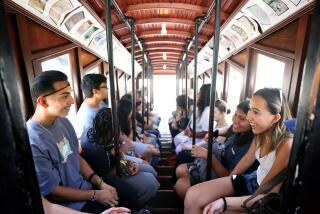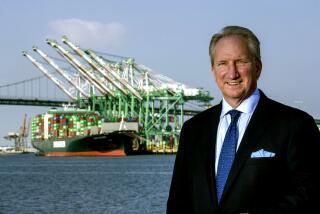Hands-On Program : Class at LACC Learns by Trading
- Share via
Students in the foreign trade program at Los Angeles City College don’t just study the import-export business.
Instead, they buy alpine hats from Austria, sell “Hollywood” bumper stickers to Taiwan, apply for letters of credit and agonize over whether to ship quickly by air or cheaply by ocean.
It’s all part of a hands-on program designed by Don Landauer, a soft-spoken LACC professor who says the best way to learn something is to get out and do it. Last spring--the first semester that the program was offered--26 students did just that. This fall, 50 more are expected to follow.
LACC’s program may be the only one of its kind on the West Coast, say university scholars and industry experts.
“It’s filling a very unique niche” in giving people a hands-on experience in international trade, said Jack Lewis, associate director of the International Business Education and Research program at the University of Southern California.
“We definitely need something like this,” said Al Mazzarella, vice president at Los Angeles customs broker L. E. Coppersmith Inc. “We tend to look among ourselves in the industry (for new employees) instead of going outside.”
Other schools teach how to ship goods, fill out forms and arrange financing, but there are few where goods actually change hands, trade specialists say.
Georgetown Program
One on the East Coast is Georgetown University, where the business school’s National Center for Export-Import Studies set up an export trading company two years ago that trades about $2,000 worth of goods each year, said Michael Czinkota, the program’s founder.
With a staggering federal trade deficit of $148.5 billion recorded last year--up $25 billion from the previous year--industry experts welcome programs such as Landauer’s as a way to prepare people for the task of exporting.
“It’s a way to turn students’ eyes outward . . . to make them competitive in international markets,” Lewis said.
Southern California seems especially ripe for hands-on trade education. If the area were considered a separate country, it would rank among the top 10 in global trade, according to the Foreign Trade Assn. of Southern California. Last year, trade through the ports of Los Angeles and Long Beach soared to $64 billion, up 13% over 1984, according to the Commerce Department. The booming Pacific Rim trade makes Southern California the nation’s busiest port area, and the result is more business for shipping lines, freight forwarders, customs brokers and so forth, none of which was lost on Landauer when he started LACC’s program in January.
LACC’s foreign trade students take 10 core trade classes, including import, export, finance, transportation and geography, and they earn a certificate in international business. For an associate degree, additional business courses are required.
Landauer says his students can either find jobs in trade-related industries, continue their studies at a four-year college or start their own business. Many in his fall semester class are foreign-born and already have connections overseas, he adds.
Take trade student Joy Crawford of Belize, for example, who wants to export farm equipment--preferably used--to her native land. Or Iris Amram of Switzerland, who dreams of importing high-fashion clothes from Paris.
Some students who have already dabbled unsuccessfully in international trade enroll so they don’t repeat earlier mistakes. “I tried to import sparkling wines from France, but I didn’t have a business license,” said student K. Chris Grigorian, an immigrant from the Soviet Union.
Some hope to duplicate the success of LACC trade student Muriel Rothenberg, who, after taking Landauer’s foreign trade class last spring, formed a company with two other women and made her first shipment of clothing to Japan in July.
“We’re selling the California life style,” said Rothenberg, who is taking marketing this fall.
LACC’s program pales in prestige and sophistication against those at New York University, UCLA and the University of South Carolina, all of which offer sophisticated MBA programs where students study international finance, use computers to simulate trade movement and formulate complex plans to penetrate markets overseas.
But those advanced programs often bypass more mundane aspects of international trade, such as filling out a shipper’s export declaration or an application for a letter of credit--a legal document issued by a bank that guarantees payment to the seller or exporter.
“Our approach is a little more academic. It’s not anywhere near as practical or nitty gritty,” said NYU’s Ingo Walter, who teaches economics and finance in the graduate school of business.
“What they’re teaching are mainly clerical tasks,” added Robert Spich, associate professor at Loyola Marymount’s business school. “An MBA would most likely buy that service from someone else.”
Landauer says his graduates can expect to start at entry-level positions that pay about $1,400 a month. Good people move up the ranks quickly, he adds.
Landauer, 59, is an engineer with an MBA who has taught at LACC for 22 years. He first got interested in foreign trade in the 1960s, when he started a business that exported electronic products to Europe.
When LACC asked him to spearhead its foreign trade program last year, Landauer remembered his own trial-and-error experiences and decided to make his courses more practical.
He wrote to about 40 foreign business schools and received firm commitments from schools in Denmark, Sweden, Austria, Taiwan and Australia to trade goods worth $5 or less.
Next he visited about 40 freight forwarders, customs brokers, railroads and airlines to brush up on current procedures and documentation.
To complete his refresher course, he spent several weeks working at Evergreen Marine Corp. in San Pedro, a Taiwan-based shipping line.
When class began this spring, the students’ first assignment was deciding on products, which eventually included pennants showing local landmarks, Hollywood bumper stickers, picture books of Los Angeles and giant T-shirts.
Next, the class produced and mailed out advertising brochures using $150 put up by Landauer to cover printing costs. At first, some foreign schools wanted to order 500 or more items for resale, but Landauer decided to keep things simple. So the class sold only about $200 worth of merchandise, he said.
In turn, each LACC student placed orders for at least one foreign item, including paper scrolls from China, hats from Austria, key chains and other knickknacks.
Landauer admits that his students fudged a bit when it came to finance. Because of the small sums involved, the class turned in a mock application for a letter of credit that was scrutinized for accuracy by local banks. But they paid for the goods with money orders to avoid bank fees.
Throughout, Landauer stressed the importance of researching trade restrictions and product liability. “You might be exporting something that’s of a sensitive political nature, like a calculator with chips used for military purposes,” he said. “Or if you import eyeglasses, the earpieces--that people chew on--might be toxic.”
Many exporters learn these skills too late, says Edwin Koblentz, executive director of the Export Managers’ Organization of California, a trade group. Koblentz teaches corporate seminars on how to prepare trade documents.
Other schools in the LACC District may soon adopt Landauer’s ideas. Domenick Miretti, a geography professor at East Los Angeles College, says a similar program is being considered there.
More to Read
Inside the business of entertainment
The Wide Shot brings you news, analysis and insights on everything from streaming wars to production — and what it all means for the future.
You may occasionally receive promotional content from the Los Angeles Times.










